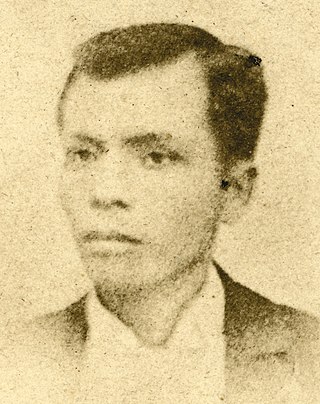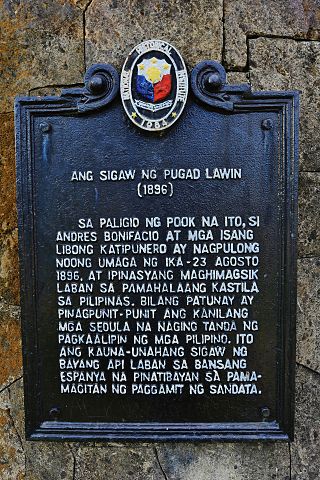| |||||
| Decades: | |||||
|---|---|---|---|---|---|
| See also: | |||||
1896 in the Philippines details events of note that happened in the Philippines in the year 1896.
| |||||
| Decades: | |||||
|---|---|---|---|---|---|
| See also: | |||||
1896 in the Philippines details events of note that happened in the Philippines in the year 1896.

As a colony of Spanish Empire and being a catholic colony, the following were considered holidays:

Emilio Aguinaldo y Famy was a Filipino revolutionary, statesman, and military leader who is the youngest president of the Philippines (1899–1901) and became the first president of the Philippines and of an Asian constitutional republic. He led the Philippine forces first against Spain in the Philippine Revolution (1896–1898), then in the Spanish–American War (1898), and finally against the United States during the Philippine–American War (1899–1901).

The Katipunan, officially known as the Kataastaasang, Kagalanggalangang Katipunan ng mga Anak ng Bayan or Kataastaasan Kagalang-galang na Katipunan ng mga Anak ng Bayan, was a Philippine revolutionary society founded by anti-Spanish colonialist Filipinos in Manila in 1892; its primary goal was to gain independence from Spain through a revolution.

Andrés Bonifacio y de Castro was a Filipino Freemason and revolutionary leader. He is often called "The Father of the Philippine Revolution", and considered one of the national heroes of the Philippines. He was one of the founders and later the Kataastaasang Pangulo of the Kataastaasan, Kagalanggalangang Katipunan ng mga Anak ng Bayan or more commonly known as the "Katipunan", a movement which sought the independence of the Philippines from Spanish colonial rule and started the Tagalog Revolution. With the onset of the Revolution, Bonifacio reorganized the Katipunan into a revolutionary government, with himself as President (Pangulo) of a nation-state called "Haring Bayang Katagalugan", also "Republika ng Katagaluguan", where in "Tagalog" referred to all those born in the Philippine islands and not merely the Tagalog ethnic group. Hence, some historians have argued that he should be considered the First President of the Tagalogs instead of the Philippines; that is why he is not included in the current official line of succession.

The Philippine Revolution, also called the Tagalog War, was a conflict waged by the Filipino revolutionaries against the Spanish colonial authorities in an attempt to win the country's independence.
Tagalog Republic is a term used to refer to two revolutionary governments involved in the Philippine Revolution against the Spanish Empire and the Philippine–American War. Both were connected to the Katipunan revolutionary movement.

The Thirteen Martyrs of Cavite were Filipino patriots in Cavite, Philippines who were executed by musketry on September 12, 1896, for cooperating with the Katipunan during the Philippine Revolution against Spain. The de facto capital city of Trece Martires in Cavite is named after them.

Ladislao Diwa y Nocon was a Filipino patriot who was among the founders of the Katipunan that initiated the Philippine Revolution against Spain in 1896.

Ramón Blanco Erenas Riera y Polo, 1st Marquess of Peña Plata was a Spanish brigadier and colonial administrator. Born in San Sebastián, he was sent to the Caribbean in 1858 and governed Cuba and Santo Domingo. In 1861, he returned to Spain but was then sent to the Philippines (1866–1871).

The Cry of Pugad Lawin was the beginning of the Philippine Revolution against the Spanish Empire.
Daniel Tirona y Tria was a Filipino politician. He became infamous for causing divisions within the Philippine revolutionary movement and for insulting and maligning Andres Bonifacio during the Tejeros Convention in 1897.

Camilo García de Polavieja y del Castillo-Negrete, 1st Marquess of Polavieja was a Spanish general born in Madrid on July 13, 1838, in a family of merchants. He was an able commander, but considered as brutal as Valeriano Weyler of Cuba.
The Battle of San Juan del Monte also refers as "Battle of Pinaglabanan" took place on August 30, 1896. It is considered as the first major battle of the Philippine Revolution, which sought Philippine independence from Spain. The first battle cry of the Katipunan coincided with the pealing of church bells at nine o'clock on the night of August 29, 1896.

The Battle of Binakayan–Dalahican was a simultaneous battle during the Philippine Revolution that was fought on November 9–11, 1896 that led to a decisive Filipino victory. The twin battle took place at the shores of Binakayan, in the town of Cavite Viejo ; Dalahican and Dagatan in Noveleta; and, to minimal extent, in Imus and Bacoor towns in Cavite, Philippines that lasted for two days before the Spanish army retreated demoralized and in disarray. The result of the battle was the first significant Filipino victory in the country's history.
This is a list of notable events that happened in the Philippines in the year 1897.
The Battle of Perez Dasmariñas was a battle of the Philippine Revolution. It occurred during the Cavite Offensive of 1897, commanded by Maj. Gen. Jose de Lachambre under Governor-General Camilo de Polavieja, as the Spanish aimed to recapture Cavite from Katipunan rebel control. Both the battle and the offensive was a success for the Spanish, and the retreat to Montalban occurred several weeks after the battle.

The Battle of Manila of 1896 occurred in Manila in the Spanish colony of the Philippines during the Philippine Revolution. Katipunan under Andres Bonifacio attempted to take the city but the attempt failed, and Bonifacio retreated to the city's outskirts. The Battle of San Juan del Monte was joined a day later when Bonifacio attempted to capture the San Juan's powder magazine, but this too failed.
The 1896 Manila mutiny was a short uprising in a military installation in Manila, the capital and seat of the Spanish colonial Government in the Philippines. The skirmish was the only recorded incident of rebellion during the revolution that happened within the walls of Manila.

The Thirteen Martyrs of Bagumbayan were Filipino patriots in the Philippines who were executed by musketry on January 11, 1897, for cooperating with the Katipunan during the Philippine Revolution against Spain.

The Battle of Sambat was the culminating battle of the first revolts of the Katipunan in Laguna. The battle was the final major action for the Katipunan chapter of "Maluningning" ending in the defeat of the rebels and martial law in Laguna province.
This is the timeline of the Philippine Revolution. It contains the events before and during the revolution.